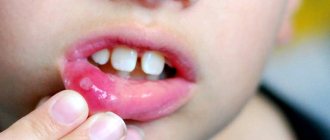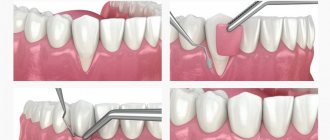What is angioedema of the larynx? Most likely, most respondents not related to medicine will not be able to answer this question. But if you voice another name for this condition - Quincke's edema - everything will fall into place.
Angioedema of the larynx is an acute, rapidly developing edema of the deep layers of the skin, subcutaneous tissue and mucous membrane. Angioedema of the larynx is very dangerous, because in the absence of emergency help, the airways can completely block, leading to asphyxia and death.
Angioedema of the larynx is an aggressive reaction of the body to external stimuli. When interacting with an external factor, the body releases biologically active substances into the blood as protective measures - histamine, bradykinin, etc. This whole process occurs with the expansion of blood vessels and an increase in their permeability. Ultimately, the lymph from the capillaries leaks into nearby tissues, causing severe swelling. The mechanism of angioedema formation is similar to the appearance of allergic urticaria. Only in the latter case, the vessels dilate in the upper layers of the skin, so urticaria is not dangerous, but in case of angioedema of the larynx - in the deep layers of the skin.
This is a relatively new medical condition. It was first described in his works at the end of the 19th century by the German physician Heinrich Quincke. Swelling of the throat develops very quickly - several hours or even minutes can pass from the moment of interaction with the irritant. Therefore, treatment and assistance for swelling of the throat should be urgent.
Symptoms of Quincke's edema.
The first sensations that a person experiences are a burning sensation and a slight tingling sensation at the site of future swelling. Then swelling occurs. Dangerous swelling appears on the face (lips, eyelids, cheeks) and neck. The tongue is very swollen. It gets to the point where a person’s face becomes like a ball, and the patient is not even able to fully open his eyes.
In the first minutes after interaction with the irritant, symptoms may appear in adults and children, such as lacrimation, problems breathing through the nose, the appearance of a dry cough and hoarseness in the voice. Another important symptom of angioedema of the throat is “wheezing”, heavy breathing. All these symptoms very quickly gain momentum and become intense. It’s as if a person was bitten by a swarm of bees - this is what angioedema looks like externally.
In addition to external changes, this dangerous condition has other symptoms: decreased blood pressure, excessive sweating, and rapid heartbeat.
Angioedema of the larynx is the most dangerous manifestation of angioedema, when swelling affects the throat and airways. An emerging cough, sore throat, difficulty swallowing, a feeling of a lump in the throat, problems with speech - all these symptoms indicate incipient asphyxia (suffocation).
When the first symptoms of Quincke's edema appear, you need to call an ambulance so as not to waste precious time. If the swelling of the larynx is not relieved soon, the person may die. Even if death was avoided and treatment of angioedema was not delayed, prolonged absence of normal breathing can lead to damage to brain activity.
How to quickly relieve facial swelling in adults
If this is physiological swelling of the face, not associated with serious pathologies that require medical supervision and the use of selected medications, excess fluid can be eliminated through certain simple measures and actions.
Taking a contrast shower or washing with cold/hot water. This method refreshes, increases tissue tone, enhances the outflow of fluid from the skin and reduces swelling.
Using ice – a couple of pieces of ice will help deal with swelling on the face quickly and effectively. In addition, you can prepare herbal decoctions with a tonic effect in advance and freeze them, using them for washing.
Facial massage is an effective remedy that helps improve microcirculation and swelling. Manual massage, the use of rollers, ice cubes, and cold spoons help. Sometimes you can first wipe your face with green tea and apply compresses with it to your face and eye area.
Causes of laryngeal edema.
In addition to knowing about the first signs of angioedema, you need to understand why, in principle, this dangerous condition can arise.
Typically, angioedema is of an allergic nature, but there are cases when the human body is affected not by allergens, but by other external factors.
The most common causes of angioedema of the larynx are:
- certain foods (for example, eggs, chocolate, etc.);
- plant pollen during the flowering period;
- fungi;
- household chemicals;
- taking medications;
- insect bites;
- dust;
- pet hair or excretions;
- exposure to open sun;
- hypothermia;
- stressful situations;
- digestive problems;
- heredity.
When do they occur most often?
Due to a number of circumstances, adds cardiologist Andrei Grachev, such as the flow of fluid to the upper half of the body in a lying position, changes in the biorhythms of hormone production (more often their active synthesis occurs at night or in the early morning hours), edema syndrome most often manifests itself in the early morning hours .
Morning
If we talk about physiological reasons, morning swelling is usually associated with constant lack of sleep, fasting or strict diets (limiting protein and fats). Sometimes swelling in the morning is caused by the wrong selection of skincare products (face cream, toner or cleanser). Also, morning swelling of the face can be caused by crying or stress in the evening or at night.
Possible swelling of the face in the morning due to an incorrectly selected pillow (it is too high, it provokes a narrowing of the blood vessels in the neck). Another physiological factor is an excess of fried, salty foods or liquids taken in the evening, before bed. In women, facial swelling in the morning can be caused by hormonal fluctuations, PMS or pregnancy. Some women report morning swelling during menopause.
Pathological causes of morning edema are mainly kidney damage. Such swelling is usually soft, mobile, appears on the face after sleep, and the skin acquires a waxy or yellowish tint. The most common causes of facial swelling are:
- glomerulonephritis - the acute form of the disease leads to edema, which lasts up to 2-3 weeks, if the process enters the chronic phase, edema is typical for periods of exacerbation of inflammation;
- Kidney amyloidosis - edema is typical of the second stage (proteinuria), when protein loss occurs and kidney function gradually deteriorates;
- membranous nephropathies - occur after taking certain medications, tumor therapy, acute infectious pathologies. Edema occurs in waves, with sharp or barely noticeable symptoms;
- chronic kidney disease (previously called renal failure) - swelling occurs gradually as renal damage progresses;
- kidney damage in severe systemic pathologies - edema is typical for nephropathy due to diabetes or systemic lupus erythematosus.
Evening
Sometimes facial swelling becomes noticeable in the evening, especially after an active day. Often this is one of the manifestations of pathologies of the cardiovascular system. Often, swelling of the face is accompanied by severe swelling in the area of the extremities - hands and feet, legs. These swellings are denser, the skin has a lower temperature than on other parts of the body, and such swelling goes away slowly. Often occur against the background of the following pathologies:
- amyloidosis of the heart and blood vessels;
- cardiomyopathy;
- sclerotic heart disease (cardiosclerosis);
- certain types of arrhythmia;
- constrictive pericarditis;
- some heart defects;
- arterial hypertension;
- cardiac lesions due to rheumatism.
Day
Sometimes facial swelling is most pronounced during the day or its appearance is not clearly related to the time of day. Among the main pathologies that lead to such edema are endocrine disorders - especially a lack of thyroid hormones (hypothyroidism). Facial swelling is especially pronounced with congenital hypothyroidism, in pregnant women or with autoimmune thyroiditis, cytokine-induced thyroiditis.
Rapidly increasing swelling of the face during the day can be a sign of allergies - to food, insect bites, cosmetics, medications and even cold. Sometimes facial swelling occurs during an attack of bronchial asthma due to difficulty breathing and fluid retention in the veins.
Facial swelling is possible in people who smoke and drink alcohol. This is due to the increased work of the lymphatic system to remove toxins from tissues.
Severe swelling of the face during the day is possible with respiratory infections and their complications - sinusitis, tonsillitis, frontal sinusitis. Swelling of the face is possible with a deficiency or excess of vitamins (especially fat-soluble ones).
Types of edema.
There are several types of Quincke's edema.
Angioedema can be hereditary or acquired. Hereditary angioedema is a rare genetic disease that was first described at the end of the 19th century and is characterized by recurrent edema. If a mother or father has this diagnosis, the probability that their child will be born with the same diagnosis is 50%. With timely prevention and proper treatment, the patient’s attacks rarely occur, and the patient lives quite well with this diagnosis. Cases of acquired disease are quite small, and are most often observed in elderly patients.
Depending on the cause that caused Quincke's edema, allergic, non-allergic and idiopathic edema are distinguished when the cause of the condition could not be determined.
Sprays and drops
Since the treatment must be comprehensive, a nasal spray acts as an additional antiallergic agent. After reading customer reviews, we have compiled a rating of the TOP 3 remedies against allergic rhinitis.
| Name | Type of drug | pros |
| Tizin Alerji | Vasoconstrictor | Fast action, long lasting results, no side effects. A small single dose is required, so the drug is economical. Approved for use by children and pregnant women. |
| Avamis (adults only) | Hormone | Reduces the inflammatory effect, lasts for at least eight hours. |
| Allergodil | Antihistamine | Does not contain hormonal substances. The drug can be used as a prophylaxis. |
To eliminate itching and watery eyes, as well as conjunctivitis, special drops are prescribed. Let's look at the best products, according to buyers.
| Name | Type of drug | pros |
| Visine | Vasoconstrictor | Quickly relieves swelling and inflammation, allowed for children from two years of age. |
| Allomide | Antihistamine | Blocks the first type of receptors. The drug is used in the treatment of conjunctivitis, as well as as a prophylaxis. |
| Diclofenac | Non-steroidal | The drug relieves inflammation and has an analgesic effect. Eliminates lacrimation. |
First aid for Quincke's edema.
How to relieve Quincke's edema? The first thing you should do when you find yourself next to a person with signs of angioedema is to call an ambulance.
What to do in case of Quincke's edema before the doctors arrive?
- First, unbutton the patient's clothes, loosen the tie, remove chains, beads, etc., thereby ensuring air flow. If you are indoors, open a window to let fresh air in.
- Make the patient more comfortable and try to calm him down by saying that doctors will arrive soon and begin treatment. This condition puts the patient into shock, which only worsens respiratory failure.
- If the problem began due to contact with an allergen, eliminate it if possible.
- Give the patient a tablet of any antihistamine that is in your home medicine cabinet. If the person cannot swallow, crush the tablet and place it under the person's tongue.
- Give the patient food more often if he can swallow, preferably with mineral water.
- If swelling is caused by contact with an allergen, give the patient activated carbon, Enterosgel or Polysorb to reduce the concentration of the allergic substance in the body.
- The patient's feet should be kept warm. You can place them in a bath of warm water or wrap them well.
- Place any vasoconstrictor drops into the patient's nose.
- It is necessary to measure the patient's blood pressure, and if it falls below 90, it is necessary to administer adrenaline to the patient.
Even if the patient feels better as a result of the measures provided, under no circumstances should one refuse medical care.
1.General information
Laryngeal edema is a life-threatening condition that manifests itself as obstruction of the upper respiratory tract and, in the case of severe asphyxia, can be fatal.
Like other local edema, laryngeal edema is an accumulation of fluid in the intercellular space, as a result of which the tissue swells and increases in size, and the air lumen, accordingly, narrows. In contrast to the spasm of the larynx described on our website (see), which in most cases resolves quite quickly, swelling of the larynx can persist for a long time; any tendency towards its progression requires emergency medical attention.
Obviously, local laryngeal edema cannot be considered an independent disease - it is always a consequence of some process, reaction or condition. In general, there are many reasons, which explains the relatively high incidence of laryngeal edema in clinical practice.
A must read! Help with treatment and hospitalization!
Treatment of angioedema of the larynx.
Treatment of angioedema consists of two stages. The first is emergency care, the second is hospital treatment. Before starting treatment, the cause of angioedema is determined, and then a treatment regimen is prescribed. This may include:
- taking antihistamines (“Suprastin”, “Loratadine”, “Tavegil”);
- corticosteroid drugs (for example, Prednisolone, Dexamethasone, Nasonex, Celeston);
- diuretics (for example, Furosemide);
- enterosorbents for removing allergens and toxins (for example, Multisorb);
- enzyme preparations (“Pancreatin”, “Festal”);
- administration of a C1 inhibitor, a blood protein whose deficiency leads to non-allergic angioedema;
- administration of fresh frozen plasma (for non-allergic edema);
- administration of androgens - sex hormone preparations (for non-allergic edema).
Frequently asked questions about Quincke's edema
How to treat Quincke's edema?
For treatment, tablets for Quincke's edema are used, namely, antihistamine drugs, glucocorticoids, and diuretics. Dexamethasone for allergic Quincke's edema gives a very effective effect and helps stop the reaction. A subcutaneous injection of adrenaline for Quincke's edema reduces blood pressure and restores breathing.
How does Quincke's edema manifest?
Angioedema manifests itself in rapidly developing swelling of areas with developed subcutaneous tissue - the face, larynx, neck, palms or feet. Sometimes burning and itching occur. The affected areas have increased density and are not pressed when pressed.
Is it possible to cure angioedema?
Symptoms usually disappear after two to three days. But if it does not subside for more than three hours, you should seek qualified help. With properly selected treatment for Quincke's edema and taking prescribed medications, the prognosis for recovery is favorable. The course of therapy depends on the causes of the allergic reaction and the presence of concomitant diseases.









